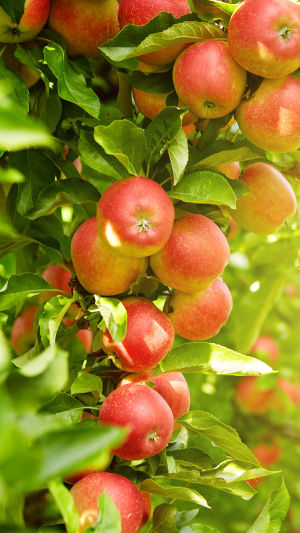Apple, a deciduous tree belonging to the rose family Rosaceae, typically grows tall with stout stems and short, thick twigs that are cylindrical. Its leaves are oval-shaped, smooth on the surface, with serrated edges, and have sturdy petioles.
The flowers are small, arranged in umbels, pale pink, and covered with fuzz on the surface. The fruit is relatively large, flattened, and spherical, with short, thick pedicels. The flowering period is in May, and the fruiting period is from July to October.
Archaeologists discovered carbonized seeds similar to apples at the Sammardenchia-Cueis site near Udine in northeastern Italy, dating back to around 4000 BC. Indirect evidence suggests that apples were already being cultivated in the Middle East during the third millennium BC.
During classical antiquity in Europe, apples were extensively cultivated, and grafting techniques were mastered. Grafting, a crucial aspect of modern apple domestication, allows for the propagation of superior varieties. The exact origins of apple grafting are still unclear.
Winter apples have been a significant food source in Asia and Europe for thousands of years, harvested in late autumn, and stored in cellars to prevent freezing. In the 16th century, Spaniards introduced many Old World plants to the Chiloé Archipelago in Chile, where apple trees thrived. Apples were introduced to North America in the 17th century, with William Blaxton planting the first orchard on the continent in Boston in 1625.
The only native apple species in the United States is the Pacific crabapple. European apple varieties brought to America spread via Native American trade routes and were subsequently planted on farms. A nursery in the United States in 1845 sold 350 "best" varieties of apples, indicating extensive breeding of new varieties by the early 19th century.
In the 20th century, irrigation projects in eastern Washington led to the development of a multibillion-dollar fruit industry, with apples as a primary product.
Until the 20th century, the preservation method for winter apples involved storing them in frost-proof cellars for personal use or sale. However, with the development of railroad and highway transportation, transporting fresh apples became more convenient, making cellars obsolete. Controlled atmosphere equipment was first used in the United States in the 1960s, allowing apples to be kept fresh year-round through high humidity, low oxygen, and controlled carbon dioxide levels.
Today, apples rank as the second most popular fruit after bananas, with an average consumption of about 19 pounds per person per year. Despite containing sugar, apples are rich in various vitamins and antioxidants, making them one of the healthiest fruits to consume. Compared to other commonly eaten fruits, apples (especially the peel) rank second in antioxidant activity.
Besides, they rank highest in the proportion of free phenolic compounds, meaning these compounds are not bound to other compounds in the apple and are more easily absorbed into the bloodstream, greatly inhibiting the growth of liver and colon cancer cells.
Since most of the antioxidants in apples are found in the peel, it's advisable to eat apples with the skin on.
Apples are among the most easily contaminated fruits with pesticides, so if you plan to increase your apple consumption, be sure to choose organic varieties. If you purchase conventional apples, soak them briefly in a solution of 10% vinegar and 90% water to remove some residual pesticides (and bacteria).
Over time and with advancements in agricultural technology, our understanding and utilization of apples continue to evolve. From orchards in ancient civilizations to modernized fruit industry chains, apples have always been part of human life, bringing us health and pleasure. While enjoying the sweetness of apples, let us also cherish the gifts of nature and strive to maintain ecological balance so that future generations can continue to savor this goodness.





